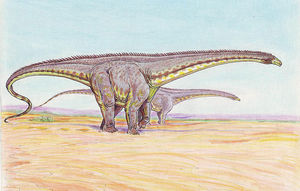Diplodocus was larger than a tennis court and weighed only as much as two elephants. When people think of huge sauropods like Brachiosaurus, they should remember that the Diplodocus may emerge victorious in a fictional deathmatch, considering its powerful 45 foot long tail (consisting of atleast 80 caudal vertebrae) that was as flexible as a whip.
The latest science research has shown us the amazing feats of this dinosaur. Here are the top 5 facts of Diplodocus, from its genius architecture to its physical feats.
Where it Lived – North America
Habitat – Floodplains
Size – 89 feet (45 foot long tail)
When it Lived – Late Jurassic, 155-145 million years ago
DINOSAUR FACT – THE “DOUBLE BEAM” WHIP-LIKE TAIL
Most of Diplodocus’ length came from its extremely long tail, so long that forced it to graze on low-growing ferns instead of taking it to the high ground like Brachiosaurus. This tail consisted of rodlike bones at its end. The interesting part about the middle of its tail was the fact that it had twin extensions called chevrons in its bones that could’ve protected its blood vessels against excessive force. It was called the “double beam” tail.
This architecture made the tail strong so it can use it as a counter-balance or use it to scare off predators by using noise made from its whiplashes against the ground. Some scientists speculate it was also used for active defending. In other words, it could’ve fought off large predators quite well since 80 caudal vertebrae makes up a lot of weight on the outside. When that much weight hits at breakneck speeds, there is going to be major damage to the predator’s bones and blood vessels. If anything, the tail would’ve made the perfect deterrent for attacks.
DINOSAUR FACT – ABNORMAL SIZE, EVEN MORE ABNORMAL WEIGHT
Diplodocus was nearly 90 feet long but its range of weight lies between 11-17.6 tons, which is light for a dinosaur of its size. This is possible because most of that length comes from its long slender neck and tail. There are deep hollows in the spinal bones that significantly reduce the weight, making movement more fluid.
It would give Diplodocus better agility and helped it swing its neck side to side to tear ferns with its teeth. The movement is needed since it was a slow-moving animal.
DINOSAUR FACT – DIPLODOCUS’S DIET, DIGESTION, AND LIFESTYLE
Diplodocus’s neck was so long and difficult to lift that its posture was almost always horizontal. That’s why it grazed on low-growing ferns instead of leaves on tall trees. Using its tail and neck to sweep the vegetation as it fed with its peg-shaped teeth, the dinosaur had the diet part handled.
Like many grazing animals today, Diplodocus may have used swallowed stones to grind up the fronds in its stomach for better digestion.
DINOSAUR FACT – DIPLODOCUS’S RELATIVES WERE EVEN BIGGER
Diplodocus is the ‘standard’ species of the Diplodocid family. Other sauropods like Apatosaurus were just as long as Diplodocus but much heavier, nearly as much as five elephants, due to the thicker bones. Dinosaurs like Barosaurus were very similar to Diplodocus except a third of their entire lengths was made up by the neck. Barosaurus had the same number of neck bones but each bone was stretched, making it so long that the dinosaur’s center of gravity was near its hips. Like Diplodocus, its front limbs were shorter than the hind limbs.
Supporting weight when rearing back to raise the neck is important. Barosaurus used that advantage to hold its neck nearly fifty feet off the ground. Other sauropods like Seismosaurus and Supersaurus made Diplodocus’s size look small, measuring well over 100 feet long.
DINOSAUR FACT – HERD BEHAVIOR, INTELLIGENCE, AND LIFE EXPECTANCY
Paleontologists used to think Diplodocus had a “second brain” but now confirm that it’s just an enlargement of the spinal cord in the area of the hip – an enlargement that was actually bigger than its tiny actual brain. In terms of the EQ quotient (Encephalization Quotient), its brain relative to its body weight was in the lowest ranks of all dinosaurs.
Diplodocus traveled in herds and migrated when food was scarce. An interesting fact is that Diplodocus laid its eggs as it walked like other sauropods in a linear fashion – their eggs have never been found in circles. The life expectancy was similar to other sauropods – around 100 years.
_________________
Works Cited
David Lambert, Darren Naish, and Elizabeth Wyse. “Double Beams.” Encyclopedia of Dinosaurs and Prehistoric Life. DK Publishing, 2008.
“Diplodocus”, Enchanted Learning.


